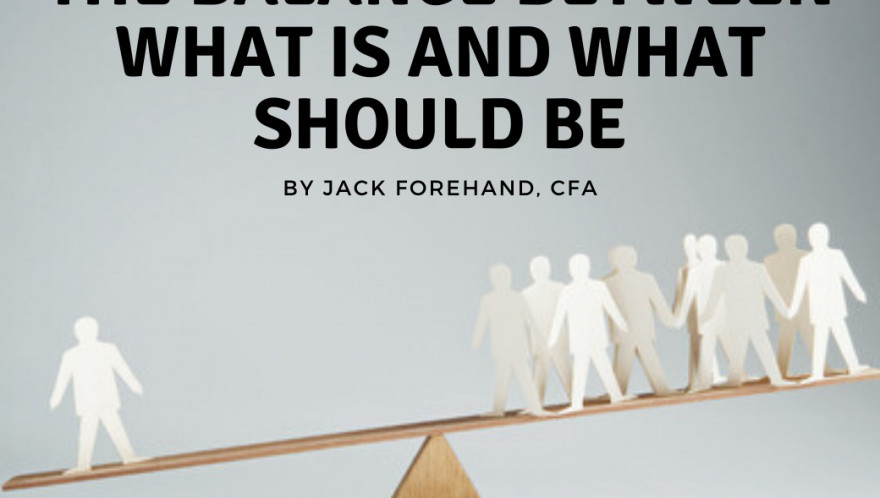I like it when things work out the way they should. It’s great when good things happen to people who deserve it. It’s great when the outcome of any situation is the one supported by the facts. It’s also great when logic and reason win out in the end.
When I came into the world of investing, I brought that mentality with me. Although I certainly recognized that reality can deviate from the way that I think things should be in the short-term, I brought in a belief that in the end, facts would ultimately drive outcomes.
And that belief has served me fairly well. Most of the time, long run investing outcomes make sense. Most of the time, the market goes up and down for the reasons that it should. Most of the time, the stocks that should perform well eventually do.
But like any rule, there are always exceptions.
And those exceptions are the things that can get many investors in trouble, myself included. The game of investing requires navigating the difficult balance between standing by your convictions and positioning yourself for the way you think things should be, while also recognizing the way things are and that the market may either take a long time to come around to your way of thinking, or not do it at all.
As we all experience a market where things are not going the way that many investors think they should be, I thought it would be a good time to look at some examples of this and what I think can be learned from them.
Don’t Fight the Fed
There have been many outspoken critics of Federal Reserve policy since the 2008 recession. Many investors think the Fed has created an asset bubble by keeping interest rates artificially low both through direct rate cuts and quantitative easing. Many also think that Fed policy has created distortions in the market and detached stock price performance from company fundamentals, which has benefitted certain types of stocks (i.e. growth stocks) at the expense of others (i.e. value stocks).
In many people minds, what the Fed has done here has created a disconnect between what IS and what SHOULD BE. Many people who believe the market is being manipulated have positioned their portfolios based on the expectation that things will change. They have set themselves up to benefit when what they see as a house of cards collapses and the market begins trading on fundamentals again.
The problem is that it hasn’t happened, even after many years. The market has continued to go up, and the same stocks have continued to lead the charge.
The person who has taught me the most about this topic has been Ben Hunt at Epsilon Theory. Like many others, he has been very critical of the Fed’s actions in the decade since the financial crisis. But he has separated that criticism from the way he looks at the market. He has voiced his personal opinions about what should be, but has formed his investment opinions based on what is. I think we all can learn from that.
The Market that Won’t Go Down
I am not sure I have ever seen a better illustration of this concept than what we are seeing in the market right now. Almost everyone I know is bearish. We are in the middle of a pandemic. We are at best in a recession, and at worst potentially in a depression. Unemployment is setting new records every week. Much of the economy is still shut down. And on top of all of that, we have recently added significant social unrest into the equation.
If I told you at the beginning of the year that all of those things would happen at once, you would likely have told me that the market would not only be down, but be down a lot. But that hasn’t happened.
So what is going on?
First, the same thing I talked about above is obviously a major factor. There has been massive government stimulus, with both monetary and fiscal policy playing a big role. But in addition to that, the market is playing its role as a long-term discounting mechanism. If you look at the value of the market as the present value of future cash flows that will be produced by companies, only a very small portion of that value is attributable to what will happen this year. So even though the economic pain of what we are going through is severe, if the majority of the effects of this will occur in the near term, an argument can be made that more significant declines are not justified.
But regardless of what you attribute what is going on to, it is easy to look at all the negative news and focus on what should be. But that can be dangerous if it causes you to not pay attention to what is.
The Great Equalizer
Although it might be easy to talk about this concept, dealing with it in reality is much more difficult. I certainly don’t have a magic bullet, but one thing I have found can be helpful is the use of momentum and trend following, which are both methods that rely solely on price. A major advantage of both of these concepts is that by definition they are “what is” or as one article put it, “Price action will never lie to us, it is a fact.”. It doesn’t matter how much bad news is out there. If the market is going up, a trend following system will ride that wave. It also doesn’t matter whether value or growth stocks are working. Momentum will just invest in what is going up regardless of whether you personally believe that the fundamentals support it. And the opposite it also true. When things turn negative, momentum and trend will adapt to that reality, irrespective of the facts driving it. Momentum can work well on its own, but it can also work well in conjunction with a strategy like value because it matches value investing’s focus on what should be with an additional focus on what is actually occurring.
Recognizing Reality
But whether you use momentum or not, it is important to recognize the reality of the world that currently sits in front of us. Sometimes that world won’t match up with what we think it should be. But that doesn’t make that reality any less true. Investing is a game of recognizing what is, even if it sometimes differs from our opinion of what should be.
Photo: Copyright: 123rf.com / pogonici

Jack Forehand is Co-Founder and President at Validea Capital. He is also a partner at Validea.com and co-authored “The Guru Investor: How to Beat the Market Using History’s Best Investment Strategies”. Jack holds the Chartered Financial Analyst designation from the CFA Institute. Follow him on Twitter at @practicalquant.









